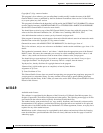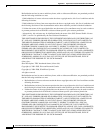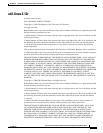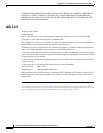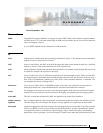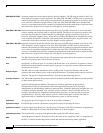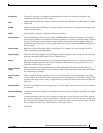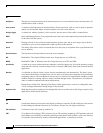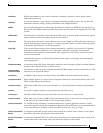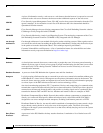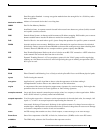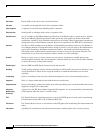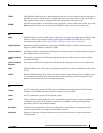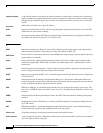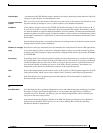
Glossary
GL-4
Cisco Intrusion Prevention System CLI Sensor Configuration Guide for IPS 7.1
OL-19892-01
B
backplane
The physical connection between an interface processor or card and the data buses and the power dis-
tribution buses inside a chassis.
base version
A software release that must be installed before a follow-up release, such as a service pack or signature
update, can be installed. Major and minor updates are base version releases.
benign trigger
A situation in which a signature is fired correctly, but the source of the traffic is nonmalicious.
BIOS
Basic Input/Output System. The program that starts the sensor and communicates between the devices
in the sensor and the system.
blackhole
Routing term for an area of the internetwork where packets enter, but do not emerge, due to adverse
conditions or poor system configuration within a portion of the network.
block
The ability of the sensor to direct a network device to deny entry to all packets from a specified network
host or network.
block interface
The interface on the network device that the sensor manages.
BO
BackOrifice. The original Windows back door Trojan that ran over UDP only.
BO2K
BackOrifice 2000. A Windows back door Trojan that runs over TCP and UDP.
bootloader
A small set of system software that runs when the system first powers up. It loads the operating system
(from the disk, network, external compact flash, or external USB flash), which loads and runs the IPS
application.
Botnets
A collection of software robots, or bots, that run autonomously and automatically. The term is often
associated with malicious software but it can also refer to the network of computers using distributed
computing software. The term Botnet is used to refer to a collection of compromised computers (called
Zombie computers) running software, usually installed through worms, Trojan horses, or back doors,
under a common command-and-control infrastructure.
Bpdu
Bridge Protocol Data Unit. Spanning-Tree Protocol hello packet that is sent out at configurable inter-
vals to exchange information among bridges in the network.
bypass mode
Mode that lets packets continue to flow through the sensor even if the sensor fails. Bypass mode is only
applicable to inline-paired interfaces.
C
CA
certification authority. Entity that issues digital certificates (especially X.509 certificates) and vouches
for the binding between the data items in a certificate. Sensors use self-signed certificates.
CA certificate
Certificate for one CA issued by another CA.
CEF
Cisco Express Forwarding. CEF is advanced, Layer 3 IP switching technology. CEF optimizes network
performance and scalability for networks with large and dynamic traffic patterns, such as the Internet,
on networks characterized by intensive Web-based applications, or interactive sessions.



